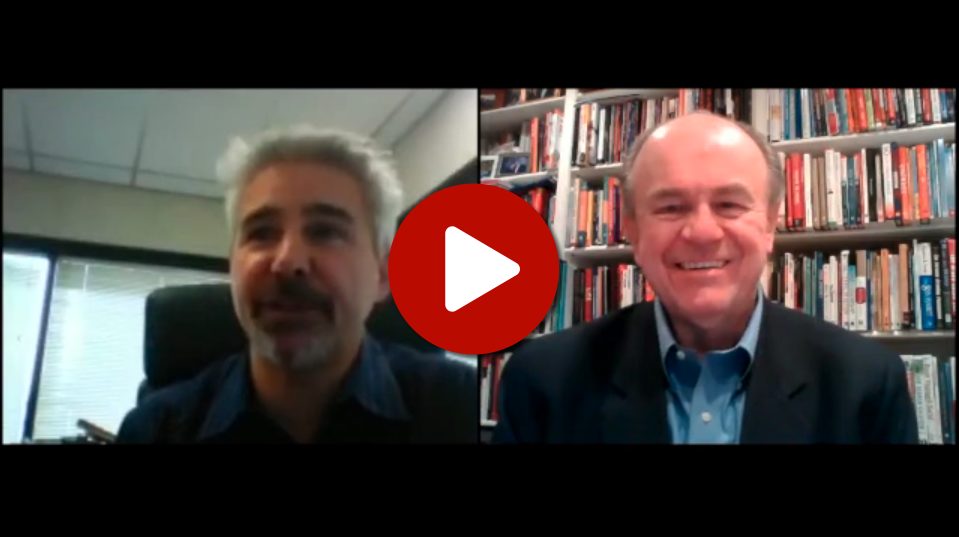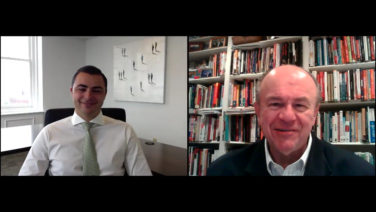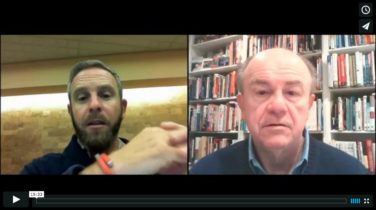R.J. Lewis, President & CEO of eHealthcare Solutions, explains what all marketers are dying to know about the Internet. Not only how to reach and target the niche audiences that are most relevant to your brand but how to measure the true ROI of your campaign. He also offers advice on digital marketing strategy and how content infusion can benefit your brand—with real-life examples of healthcare marketing campaigns that have proven successful. Finally, R.J. examines one of the biggest trends in digital marketing today—the importance of authentication and more granular targeting. R.J. Lewis can be reached at rlewis@ehsmail.com or on Twitter @rlewis.
PM360 RJ Bud from PM360 Online on Vimeo.
Transcript
Bud Bilanich: Hi, everybody. This is Bud Bilanich. And this is the first issue of Experts Corner interviews for PM360. And I’m really excited today because we have R.J. Lewis with us and R.J. is an expert’s expert. He’s the Founder, President and CEO of a company called eHealthcare Solutions. So as we get started, R.J. tell us a little but about what eHealthcare Solutions does and then we’ll get into talking about how your area of expertise can benefit the pharma marketers.
R.J. Lewis: Sure. Well thanks for having me on today. Basically, what eHealthcare Solutions does is we were the first ad network to say we’re going to focus purely in the vertical of healthcare, and we aggregate niche audiences for the measurable benefit of both marketers and publishers, and what I mean by that is we find hard-to-reach niche audiences on the Internet through hundreds of different websites. We work with over 75 medical publishers, societies, associates and entrepreneurs who’ve started healthcare websites and we—those 75 publishers own and operate over 400 different digital media assets.
Most of those are websites, some of those are email newsletter lists, some of those are mobile apps, but we’re purely focused in digital. And then we help marketers to find those really hard-to-reach niche audiences. So whether you’re looking for patients who suffer from IBS or Crohn’s disease or HIV or whether you’re looking for physicians by specialty or hospital or retail-based pharmacy or nurse practitioners, PAs, etc., we’re able to put all those audiences together across a wide variety of websites to be able to create the size and scale and competitiveness with some of the largest portals out there.
Bud Bilanich: Well that’s really cool. You can—so you can really target, at a fairly granular level, different types of audiences that marketers might want to reach.
R.J. Lewis: Very much. I mean that is the holy grail of the web. That’s why I think the web is so valuable because you can target at a very, very specific level and add to that the measurability of reporting and the ability to actually see what kind of impact you’re having, and that’s really what makes the web special.
Bud Bilanich: And so when you talk about measurability of reporting, what are the kind of things that you’re—that you can provide there and that marketers might really find of use and helpful to them?
R.J. Lewis: So I’ll give you a couple of easy examples. We have a whole ROI briefcase of intelligence tools through various partnerships that we work with, with groups like Nielsen, for example, where we can look at large-scale consumer campaigns, leverage Facebook data to come back and report on, demographic information, how many males did you reach, how many females, what age, characteristics, etc. We’ve got other partnerships in place where we can look at the actual interactivity of the ad unit itself. So what I mean by that is we can look at the mouse-overs on the ad.
So even if a user didn’t click on your ad, we can measure things like was the ad viewable, was it above the fold or was it below the fold? Was it—sometimes even below-the-fold ads can have value if the user’s reading an article and they screen down and it gets exposure. So we can do a campaign, for example, targeting a high prescriber list and we can come back with a report that shows you exactly how much time in minutes your ad was present on a computer screen above the fold, in view, for your target audience. We can tell you not just the basics of how many impressions did you get and how many clicks, but how many viewable impressions did you get, what kind of interactions happened with the ad unit itself, meaning as people mouse over that ad unit, what parts of the ad are they mousing over? So you can make your creative, even in your other media offline and online both, you can make it better and more appealing based on how people are interacting with it.
Bud Bilanich: Well so you have overwhelming amounts of data. I might say if I’m a product manager, “My gosh, what am I going to do with all that stuff?” What are some of the metrics that you find that most marketers find helpful?
R.J. Lewis: I think the holy grail metric that everybody’s looking at, and we can do this as well with any number of different third-party sources, is to try and measure true ROI and what kind of prescription lift did they got off of a campaign. We can work with various partners to do that as well. The challenge I think most marketers have, at least when it comes to digit and measuring that, is the cost of the measurement of a campaign like that can easily approach six figures to really determine whether or not you have an ROI, and a lot of the media spends are much smaller than that. So nobody’s going to spend a $50,000 media spend and then turn around and spend $100,000 to try and measure it.
So you have to be talking about a reasonably large spend, and we’ve found that’s usually in the—it starts at about a $500,000 range and anybody spending seven figures is typically going to want to look at some kind of an ROI metric. But a lot of times, if they’re only spending $50,000 or $100,000, it’s just not—it doesn’t make sense economically to turn around and try to measure it to that level of script lift.
Bud Bilanich: So for the measuring ROI, we’re talking like big campaigns for big products?
R.J. Lewis: Typically, yeah.
Bud Bilanich: But you can also do—your service is also valuable for marketers with smaller campaigns and smaller products. What are some of the ways that the—somebody who’s running a smaller product or managing a smaller product might be able to work with you?
R.J. Lewis: So I’ll give you a great example. I won’t mention the brand by name, but we’re working with a medical food product right now for IBS. This is a product that actually needs a prescription from a doctor but it’s a food and it helps IBS sufferers. And we’re doing a whole host of things for them on both the professional side and the consumer side. One of the things that we’re doing is working with a market leading consumer site for IBS called http://www.ibsgroup.org.
It’s probably the leading site on the web when it comes to IBS sufferers, and we’re doing what’s called a content infusion program. This is a form of native advertising where we’re taking actual content and information, educational information, from the creator, the manufacturer of the product, and we’re imbedding into the content to put it right in front of users that suffer from the condition. You know, I call it you want to fish where the fish are. Rather than trying to always drive individuals to your property or your brand.com site, let’s actually take some of your good quality educational material and put it out in front of the community that’s receptive to it.
Bud Bilanich: Well I’ve been reading a fair bit recently about the whole concept of native advertising and that seems to be almost like custom—almost like a custom made for kind of like the service that you offer.
R.J. Lewis: It is in many respects. I mean at the end of the day you can think of us as a distribution channel. We’re a syndication mechanism that sits between the manufacturer, the marketer and the publisher who has the eyeballs and creates great content and builds traffic. And at the end of the day, much of what we syndicate is pure play advertising, but we can also syndicate content, we can syndicate a lot of different marketing elements through that channel. So native advertising does fit well within what we do.
Bud Bilanich: Yeah. Well, you know, a little while back you were talking a little bit about working with creative and then, you know, the marketing people. So I’m thinking of that as kind of like a triangle, you know, your product manager, your creative people let’s say at the agency, and you. How does that work? Can you talk a little bit about just how that whole interaction works?
R.J. Lewis: Sure. So our clients are both agency clients as well as manufacturers directly. Like in the case of the medical food product I just mentioned, we work directly with the manufacturer. Depending on the brand and the size of the brand, they may or may not have an agency of record and they may or may not have a digital agency of record. So sometimes we work directly with the client when the agency that they’re working with just—it’s just not within their bailiwick to do digital. Other times, we’re thrilled to work with digital agencies who really understand and get the medium because we can—together we can collaborate and come up with more innovative solutions than we often can with just the manufacturer alone or just the agency and the manufacturer alone.
So our collaboration with agencies is very deep. Typically, where our responsibility starts and where their ends is with the creative itself. So they will typically go through overall, create a brand strategy, go all the way through to creative production, and then they will turn to us and they’ll say, “Hey look. Here’s our target audience, here’s what we’re looking to achieve. Here’s how we’re measuring it. Put a proposal together to tell us how we should best execute on this,” and we’ll then pick up the distribution, delivering their creative assets out to our publishing partners and to the right audience.
So we’re responsible for delivering the product to the audience. They’re typically responsible for the creative and what happens beyond the creative when you get to the page. But I will admit, in between there, there’s some overlap. There are situations where we will take on creative development for a client that doesn’t have an agency, for example, and there are situations where we’ll build out micro sites, we’ll build out engaging content because we know our audience better. We know how they’re going to react or respond to different types of executions.
Bud Bilanich: Okay. Not to oversimplify it, but you guys were some of the first people in the digital place in this and certainly in the healthcare world, and you’re a big believer in the power of digital media, and what I’m hearing you say is that it’s important for pharma marketers to pay attention to digital because it’s only going to grow and to be able to form that collaboration between themselves, an agency if they have one, and you as a distributor of content, is really an important part of being able to manage a profitable brand these days.
R.J. Lewis: Absolutely. I am a huge believer in digital. I always like to say I believe in it so much I bet my career on it. And I would agree; it is growing. Whatever statics you look at, digital continues to grow. It’s shifting.
The growth is coming in different areas. So mobile, for example, is one of the areas that I don’t think pharma is doing enough in—and significant amounts of traffic. We have some publishers where half of their web traffic today is coming from mobile devices. For most it’s still in the 25% to 30% range, but there are some utilitarian types of products where half or more of the traffic’s coming from mobile devices.
And pharma for the most part has been relatively quiet on the mobile front, so I think they’re experiencing the same kind of delay that they did in getting into digital. I think they’ll get there, but they’re still grappling with a lot of the medical legal issues over screen size and displaying fair balance in a way that can be acceptable to the FDA, etc. So I do think it’s shifting, but digital, there’s no doubt, is going to continue to grow on all fronts, some faster than others. You know, online video would be another great example where I don’t think pharma has been as aggressive as some other industries, but again, I think they will get there. And in some ways they’ve been doing direct-to-consumer television for so long, online video should be a very natural fit, but you know, they can’t have a 60-second spot, which you know, often they want for the display of fair balance. Online video just doesn’t work that way.
Bud Bilanich: Yeah. Well you know, you talk mobile and mobile is more than just optimizing your site so it can be read on a mobile device, correct?
R.J. Lewis: Absolutely. You got to fish where the fish are, and if your target audience—particularly for brands like, you know, dermatology products for acne, for example, if you’re target audience is using mobile as their primary source for information and connectivity, you really need to figure out how to be there.
Bud Bilanich: All right. Well, you know, R.J. this is tremendous. You truly are an expert in this whole area. Thank you for your time. Any last bit of advice, wisdom, that you can offer PM360 readers on using digital as a way of reaching target audiences?
R.J. Lewis: Well, you know, I think one of the things that’s kind of—if you look at overall trends and say well what’s happening that you should be inquiring about, pressing your agencies for information on, one of the big trends we’re seeing in the professional space is authentication. So it’s not enough for a lot of brands now to say, hey, I’m comfortable being on a large medical society website or in a large well-known journal and running on a run-of-site basis. Many brands are pushing for more and more authentication and more and more granular targeting. And they’ve done this offline for a long time so it’s not a surprise, but they want to do list-match targeting. So we’ve been working with publishers and educating publishers on really adopting the authentication process, registration process, so that we can deliver finer and finer granular targeting to the end client.
It’s kind of funny, Bud because I ended up following in my parents’ footsteps. My parents are both educators and I chose a different career path in that I became a serial entrepreneur on the Internet, but at the end of the day when you boil down my job on a daily basis, it’s really all about educating still. It’s educating marketers about digital and educating our publishing partners about digital. We do an equal amount of education on both sides, and so the more we can help bring them up to speed and push the industry along and continue to push that envelop, the more excited I get.
Bud Bilanich: Well that’s what happens when you’re first into a field. You have to do an awful lot of education because it takes a while for people to even understand what you’re trying to do, right?
R.J. Lewis: It does, it does.
Bud Bilanich: All right. Well, R.J. thank you so much. This is Bud Bilanich. R.J. Lewis has been my guest today. We’re talking about Experts on Call for PM360. Tune in next month and we’re going to have another great interview for you. So R.J. thanks again so much. Appreciate your time.








